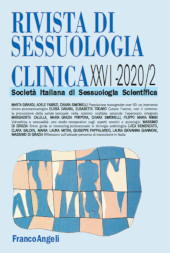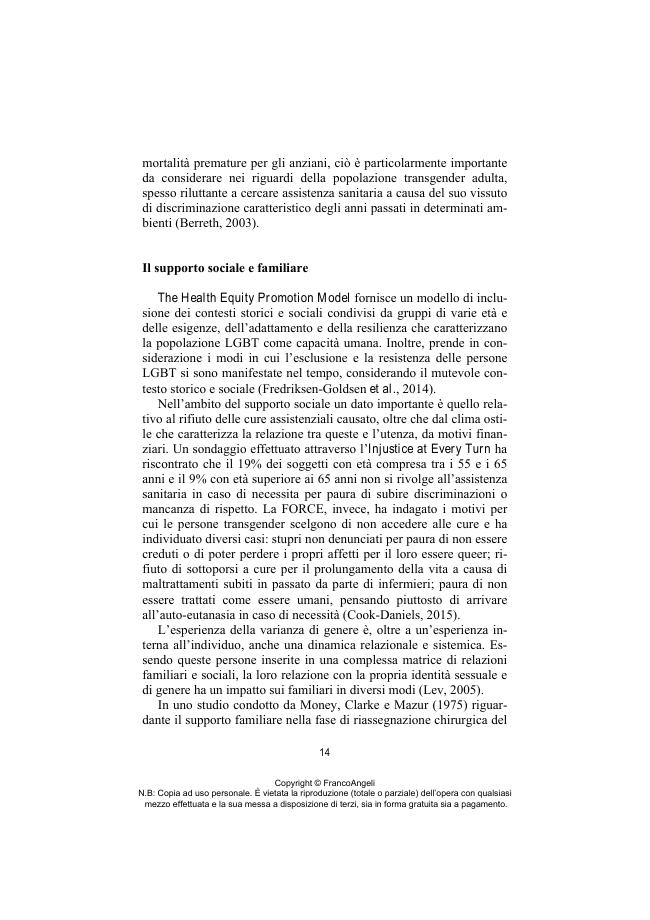2020 - Franco Angeli
Articolo
Versione Digitale
Download | Copia/incolla | Stampa
Popolazione transgender over 50 : un intervento clinico psicosessuologico
5-22 p.
- Il concetto di identità di genere è stato motivo di interesse e di studio negli anni fino a giungere alla sua concezione transgender, caratterizzata da un lungo percorso di depatologizzazione che parte dai primi studi di differenziazione tra sesso e genere fino ad arrivare alle classificazioni che i vari manuali diagnostici oggi ci presentano. La concezione transgender dei generi supera la concezione binaria, proponendo una visione fluida che legittima l'esistenza di una varietà di identità di genere in cui potersi riconoscere. I bisogni relativi all'invecchiamento e alla salute degli anziani LGBT sono scarsamente affrontati nei servizi, nelle politiche o nella ricerca.
- La popolazione transgender over 50, la quale ha vissuto in un contesto sociale e storico caratterizzato da forti discriminazioni, si trova ad affrontare una fase di transizione della vita in cui è importante considerare le caratteristiche peculiari di tale vissuto come transgender e gli aspetti relativi alla salute fisica e al supporto sociale. Affacciarci alla visione di invecchiamento transgender vuol dire adottare una prospettiva che si distanzia dagli script eteronormativi prevalenti nella società, e che si avvale di concezioni tipiche di tale vissuto, come quella di queer time e queer space. L'obiettivo di tale contributo è quello di evidenziare le problematiche e le esigenze della popolazione considerata per poter promuovere una figura di clinico attento e consapevole delle peculiarità dell'utenza considerata e un intervento clinico psicosessuologico ad hoc che adotti un approccio biopsicosociale. [Testo dell'editore].
- In recent years, the concept of gender identity has been under study until reaching the transgender concept which goes beyond the binary concept of sex and gender. It proposes a fluid vision that legitimizes the existence of a gender identity variety in which one can recognize itself. Therefore, the concept of gender identity goes through a long process of depathologization, as happened for example to the concept of "homosexuality" in previous years. This process starts from the first studies of differentiation between sex and gender and goes through the modern classifications that the many diagnostic manuals present us. The DSM-5 with its label of "gender dysphoria" emphasizes the personal distress associated with this condition, whilst the PDM-2 emphasizes its non-pathological dimension by naming it "gender inconsistency" while confining it in the appendix section. The health of the elderly LGBT population and their ageing-related needs have so far been poorly addressed in services, policies, or research.
- The understanding of this LGBT population life process cannot be separated from their social and historical life context that passed through the "Greatest Generation" and the one of the "Baby Boom", both characterized by strong experiences of discrimination and victimization. Moreover, talking about the transgender population over fifty, it faces a transition life phase in which one cannot ignore the peculiar characteristics of the experience as a transgender person and all the aspects related to the social support and the physical health. To look at the transgender ageing-perception means adopting a perspective that takes distances from the heteronormative scripts largely prevailing in the society, and that makes use of the typical concepts of this identity experience, such as queer time and queer space.
- For a broader understanding of the phenomenon is thus necessary to integrate two fundamental perspectives, the queer view and the gerontological one, contributing to the growth of awareness about ageing, identity, and human development. By adopting a health equity point of view, it is possible to identify the risk and protective factors that, on an individual level, have the greatest influence on the ageing process and psychological well-being. Among them, minority stress and resilience resulted to be the most relevant ones. On a physical level, during ageing, our body and mind can suffer from a grad-ual decline. Hormonal and surgical therapies for sex change can contribute to it and can represent some additional risks. To control this, the hormonal treatment is given following the Endocrine Society guidelines.
- The relationship between public health and transgender users has been characterized by a discriminatory climate that makes this population often reluctant to seek health care and negatively affect their physical health. Besides, also the social and family support that characterizes the transgender population over 50 influences their real and perceived well-being. Taking into consideration the issues concerning relations with public health, family reactions, as well as those encountered in the social sphere characterized by heavy prejudices, and the impact that all this has, it emerged the need to promote constructs such as health equity to overcome these problems and improve the living conditions of the transgender population.
- The goal of this contribution is hence to highlight the transgender population problems and needs in order to promote a clinician who is accurate and conscious of the peculiarities of the users and to support an ad hoc psychosexual clinical intervention adopting a biopsychosocial approach. The ultimate aim is to offer a service that is free from any heteronormative prejudice and binary conception of the genre, promoting the creation of a listening and analysis place in which the user can feel confident in exploring and expressing his needs and desires, which will be embraced and supported respecting his legitimacy and value. [Publisher's text].
Fa parte di
Rivista di sessuologia clinica : 2, 2020-
Informazioni
Codice DOI: 10.3280/RSC2020-002001
ISSN: 1972-5183
PAROLE CHIAVE
- Identità di genere, transgender, invecchiamento, LGBT, intervento clinico psicosessuologico, approccio biopsicosociale
- Gender identity, transgender, ageing, LGBT, psycho sexological clinic intervention, biopsychosocial approach
-
Nello stesso fascicolo
- Popolazione transgender over 50 : un intervento clinico psicosessuologico
- Curare l'uomo, non il sintomo : la promozione della salute sessuale nella sclerosi multipla secondo l'approccio integrato
- Vulvodinia e sessualità : uno studio comparativo sugli aspetti emotivi e psicologici
- Breve guida al counseling psicosessuale in chirurgia andrologica
- Riflessioni sull'attuale percorso di transizione in Italia
- Recensioni
- Segnalazioni bibliografiche
- Convegni



